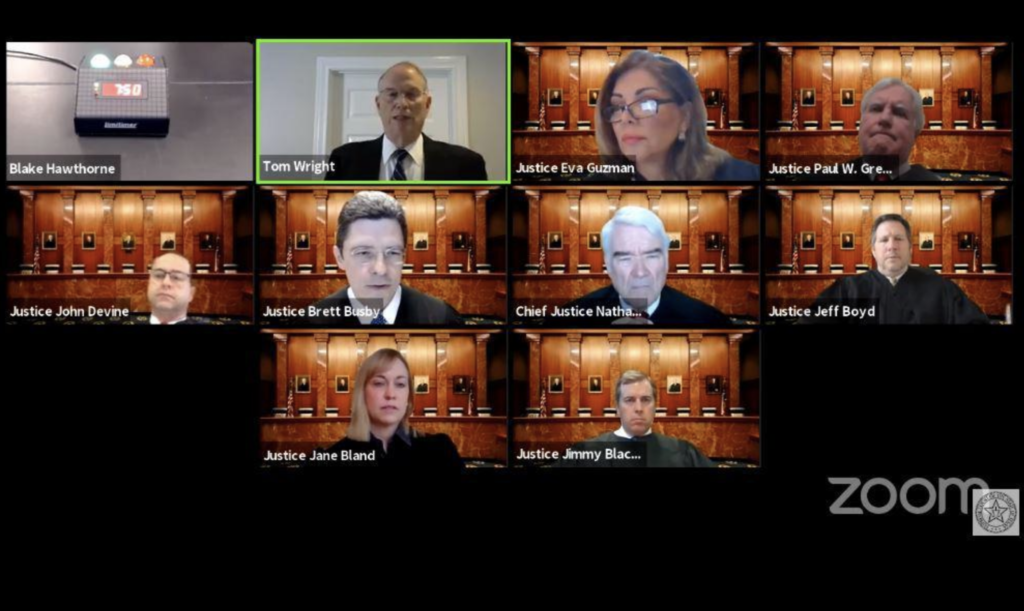
The Texas Supreme Court on Wednesday became the second state high court in the nation to hear oral arguments remotely, tapping technology to keep the gears of justice grinding during a time of closed courtrooms due to the coronavirus outbreak.
The court heard arguments in three cases Wednesday using videoconferencing technology that allowed justices to preside from their homes. Lawyers presenting arguments also spoke remotely from their homes or offices.
Observers watching the livestream on the court’s YouTube channel saw the nine robed justices in separate squares on a grid. Each had the same photo of their courtroom bench as their background. The lawyers appeared in front of different backgrounds such as a plain wall or bookshelf.
Chief Justice Nathan Hecht said in an interview with The Lawbook that he and two other justices joined the videoconference from their offices at the court. Hecht said he feared his dogs would weigh in on the cases if he logged in from home.
Hecht, who heads the National Conference of Chief Justices, said Texas followed Ohio by one day in pioneering arguments via videoconference.
“It’s just not that hard to do,” said Hecht, adding that he hopes the state’s courts of appeals will begin hearing cases remotely.
The court used Zoom, a software platform that has made news for being vulnerable to hackers who have interrupted live video events. Hecht said he was confident that the business version of Zoom used by the court coupled with strong security settings would prevent intruders.
The Office of Court Administration is working with judges around the state to use the platform and about 1,000 judges have signed up in the last two weeks, said Hecht. He said there have been 2,000 videoconference hearings around the state, showing the technology’s potential to change the system for the long term.
The chief justice said he considered having the three cases and a fourth set for later this month submitted on briefs or being reset for argument this fall.
“No, these folks need an answer and we should do our best to give it to them,” he said. “Oral argument is an important traditional part of deciding a case. It’s also important for people to know that the justice system is doing its best to function during this time.”
The first appeal the court heard was W&T Offshore Inc. v. Wesley Fredieu, an oil platform injury case. Fredieu was a maintenance contractor’s employee who suffered a severe arm injury while trying to fix a regulator on the rig owned by W&T Offshore. Fredieu filed a personal injury claim against W&T.
A Harris County jury found Fredieu was not W&T’s “borrowed employee” and that federal workers’ compensation laws did not bar his claims. The jury awarded Fredieu $1.7 million, but the judge threw the award out and concluded that Fredieu was a borrowed employee who must be compensated under the Longshore and Harbor Workers’ Compensation Act.
In 2018, Houston’s 14th Court of Appeals reversed the trial court’s judgment, saying that disputed fact issues preclude a matter-of-law determination that Fredieu was W&T’s borrowed employee. The COA remanded the case for entry of judgment in Fredieu’s favor.
Thomas Wright presented arguments to the Supreme Court for W&T and Kevin Dubose presented for Fredieu. (Justice Debra Lehrmann recused herself from the case).
Wright, who has appeared before the court at least 15 times, said he was excited at the opportunity to be the first to test the technology. “I had a chance to practice and I know Kevin Dubose has done a lot of this,” he said. “We’ve had a lot of Zoom meetings in the last couple of weeks.”
He appeared during a practice run in a conference room at his Houston firm, Wright, Close & Barger, but the lighting was too bright. Wright decided to set up his computer at home before a closed white door.
“I was standing in a room in my own house,” he said. “I was able to put that out of my mind and focus on the justices and listen to their questions. I thought it went about as well as could be expected.”
The court also heard arguments in a dispute over a charter school lease and a concrete-block manufacturer’s defamation case against a competitor.
The Zoom platform uses a grid format with each justice shown in a separate square, similar to the opening graphic of the Brady Bunch classic TV show. Wright appears in one block and the court’s countdown clock in another. When a justice speaks, their square is highlighted.
Other than a few brief technical glitches likely due to dropped internet connections, the arguments went smoothly.
Hecht sees great potential in the technology even after courthouses reopen. The court also is using Zoom for its weekly case conferences.
“This is going to be one of the profound changes in the justice system going forward,” Hecht said.
For his part, Wright hopes the Supreme Court returns to tradition.
“They’ve got a beautiful courtroom,” he said. “There’s more collegiality for the court to be there together and a better experience for lawyers to do arguments live in the courtroom.”
Watch the court’s arguments in W&T Offshore v. Fredieu here.
